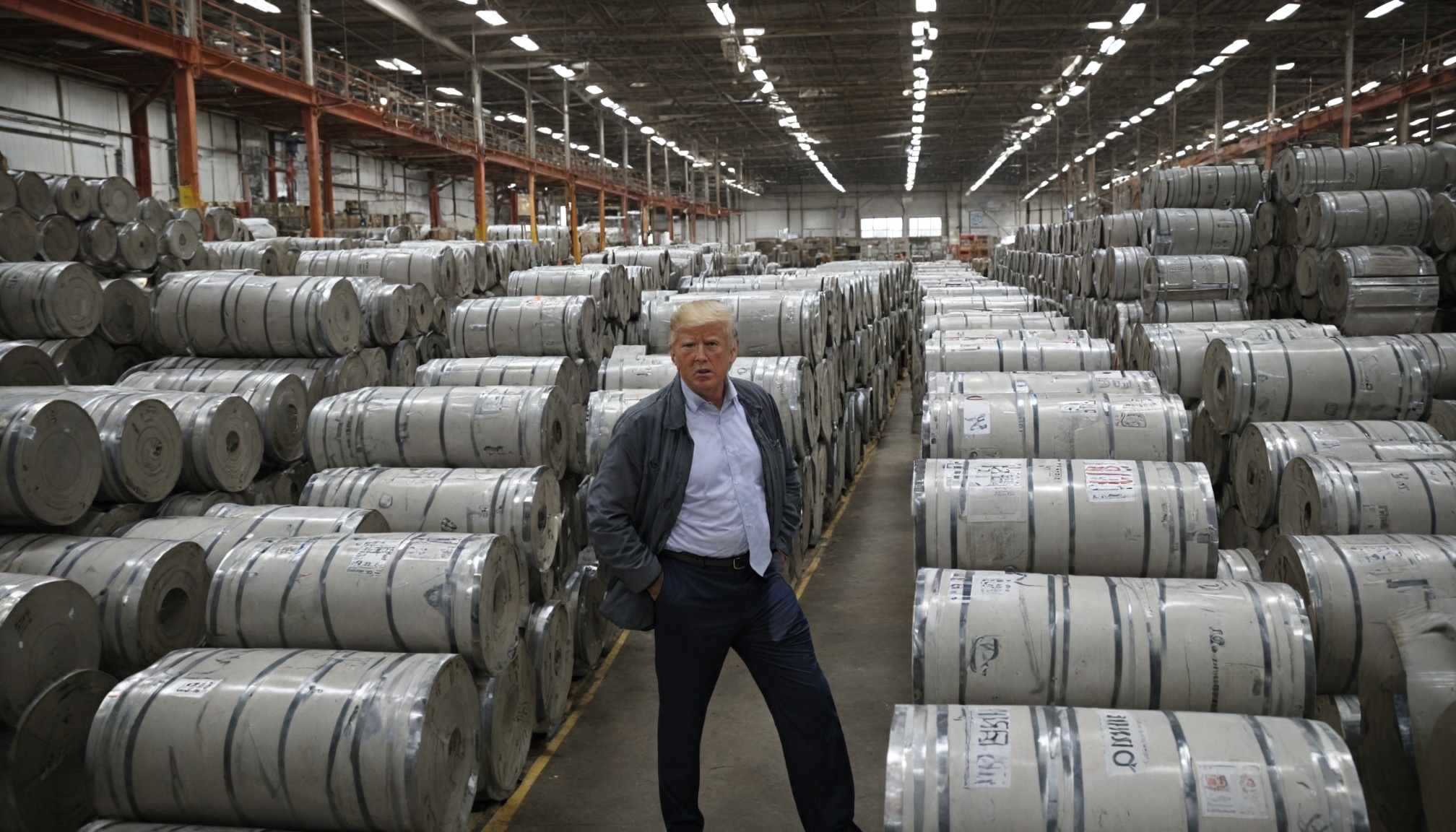
Trump's sweeping tariffs push rates to 22.5%, highest since 1909, triggering economic contraction, market turmoil, and consumer cost surges of $3,800 per household.

Drivetech Partners
President Trump's sweeping tariff policies have raised the average US tariff rate to a staggering 22.5%, the highest level since 1909, triggering alarming economic consequences including a 0.3% contraction in Q1 2025. American businesses have frantically begun stockpiling imports ahead of implementation dates, creating economic distortions while financial markets tumble amid growing recession concerns from major financial institutions.
Key Takeaways
Trump's April 2nd executive order imposed minimum 10% tariffs on all imports, with China facing over 104% in total tariffs
JPMorgan warns a recession later this year is "more likely than not" as GDP growth projections fall
Consumers face average losses of $3,800 per household with significant price increases on everyday goods
The S&P 500 fell below 5,000 points for the first time in almost a year following the announcement
International trading partners have begun retaliatory tariffs, with China implementing an 84% tariff on US imports
Unprecedented Tariff Policies Reshape Economic Landscape
The tariffs imposed through President Trump's April 2nd executive order represent the largest tax hike since 1993, increasing federal revenues by $166.6 billion (0.55% of GDP) in 2025. The minimum 10% tariff on all US imports dramatically changes the trade landscape, with 57 specific countries facing even higher tariffs ranging from 11% to 50%. China has been hit particularly hard with an additional 50% tariff, bringing their total tariff rate to over 104%.

The economic impact was immediate, with Q1 2025 showing a concerning 0.3% contraction as businesses rushed to stockpile imports ahead of implementation dates. This scramble has created significant economic distortions, contributing to supply chain bottlenecks and pricing volatility across multiple sectors.
Recession Warnings and Devastating Growth Projections
Economic forecasts paint a bleak picture for growth in both the short and long term. US real GDP growth is projected to be 0.9 percentage points lower in 2025 from all tariffs implemented this year, with the April 2nd announcement alone expected to reduce GDP growth by 0.5 percentage points.
JPMorgan has issued a stark warning that a recession later this year is "more likely than not" as tariffs create significant headwinds for economic activity. Long-term projections are equally concerning, with estimates that the US economy will be persistently smaller by 0.6% (equivalent to $180 billion annually) due to these policy changes.
The Wharton Budget Model forecasts even more significant long-term damage, projecting that Trump's tariffs will reduce long-run GDP by about 6%. This persistent economic contraction could have lasting implications for everything from employment to federal debt service.
Consumer Pain: Skyrocketing Prices and Household Costs
American consumers are facing the direct impact of these policies through significantly higher prices on everyday goods. Price levels from all 2025 tariffs are expected to rise by 2.3% in the short run, translating to an average consumer loss of $3,800 per household.
The pain isn't distributed equally, however. Households at the bottom of the income distribution face annual losses of $1,700, representing a much larger percentage of their disposable income. After-tax income is projected to decrease by approximately 1.2% across most income groups.
Specific consumer goods are seeing dramatic price increases:
Apparel prices rising by 17%
iPhones potentially increasing by up to 40%
Video game consoles jumping from $400 to $500
US-assembled vehicles increasing by $3,285 per vehicle
Foreign-made cars potentially rising by $5,000-$15,000
Market Chaos and Financial Instability
Financial markets responded immediately to the tariff announcements with significant volatility. Global stock markets plummeted in early April, with the S&P 500 falling below 5,000 points for the first time in almost a year. This market reaction reflects deep concerns about future corporate earnings and economic growth.
Particularly concerning for economists is that US Treasury securities have not behaved as expected safe havens during this market stress. This unusual pattern points to deeper financial system concerns that could compound the economic challenges.
Market uncertainty has led to delayed investment decisions and fluctuating currencies, with some analysts raising concerns about the dollar's role in the global financial system. This volatility is expected to continue as businesses adapt to the new trade landscape, creating additional challenges for financial planning and stability.
Trade Collapse and Industry Impact
The tariffs are projected to have a devastating impact on trade, reducing total imports by $6.9 trillion over the next decade. JPMorgan estimates the tariff on China alone amounts to a $400 billion tax hike before substitution effects, while import demand is expected to drop by nearly $800 billion (23%).
Specific industries are forecast to face particular challenges. The Bank of America estimates auto sales will drop by 2.5 million this year due to tariffs, creating ripple effects throughout the manufacturing and retail sectors.
Companies are frantically stockpiling imports ahead of tariff implementation, contributing to economic distortions. This rush to beat tariff deadlines creates temporary surges in shipping and logistics demand, followed by potential sharp drop-offs, amplifying the economic instability.
International Backlash and Escalating Retaliation
The international response has been swift and significant. China has retaliated with an 84% tariff on US imports, creating additional challenges for American exporters. This has led JPMorgan to reduce China's full-year 2025 growth forecast to 4.4%, illustrating how the trade war damages both economies.
President Trump announced a 90-day pause on additional higher tariffs affecting around 80 countries, but this temporary reprieve hasn't calmed international tensions. Retaliation from trading partners is amplifying harm to US agriculture, mining, and manufacturing sectors, which are particularly vulnerable to export barriers.
Currency markets have also responded, with the Chinese yuan moving up 1.6% to 7.34 since mid-March with expectations of further devaluation. These currency movements could further complicate trade relationships and create additional economic uncertainties.
Labor Market Consequences and Wage Depression
Workers across the economy face significant challenges from these policy changes. The Wharton Budget Model projects wages will be reduced by about 5% in the long run, creating a substantial hit to household purchasing power.
The tariff policies create complex employment impacts that vary by sector. Economists Kadee Russ and Lydia Cox found that steel-consuming jobs outnumber steel-producing jobs 80 to 1, illustrating how protectionist policies often hurt more workers than they help.
Sectors most reliant on foreign exports (agriculture, mining, and manufacturing) are projected to be hit hardest by retaliatory measures. Worker displacement and industry restructuring are expected as import-dependent businesses struggle to adapt to the new cost structures.
Revenue Projections amid Economic Contraction
Despite the economic damage, the tariffs are projected to raise substantial federal revenue. Estimates suggest tariffs will generate $5.2 trillion in new revenue over the next 10 years. The Peterson Institute estimates that a 15 percentage point tariff increase would generate $3.9 trillion over a decade before accounting for economic impacts.
However, these revenue projections must be viewed in context. After accounting for economic effects, the net revenue gain would be $3.2 trillion. If other economies retaliate, as they have already begun to do, the net revenue gain would shrink to $1.5 trillion.
The Wharton Budget Model projects $16.4 trillion in tariff revenue over 30 years, but this must be weighed against their projection of a 6% reduction in long-run GDP, which would significantly reduce other tax revenues and increase social safety net costs.
Sources
Wharton Budget Model - Economic Effects of President Trump's Tariffs
PIIE - US Revenue Implications of President Trump's 2025 Tariffs
Tax Foundation - Trump Tariffs Trade War
JPMorgan - Insights on US Tariffs
Yale Budget Lab - Fiscal, Economic, and Distributional Effects of All US Tariffs




